The testing ground. Day 4.
A four day attempt of an East-West traverse of the Southern Alps, from the Hopkins River to the West Coast Highway, encompassing the Landsborough and Karangarua Valleys.
This is day 4 of a multi-day journey. Heres a link day 1, day 2 or day 3 if you’d like to read them first.
Day 4
The sky at last
I woke woolly headed. I slugged across the hut in my sleeping back to the stove and flicked the cooker on. I watched the steam start to swirl from it. With a start I realised my toe didn’t hurt. It had kept me awake most of the night, but in the few short hours of sleep the pain had disappeared. I wriggled my toe and gritted my teeth in anticipation of the pain. When it didn’t come, I pulled my foot from the bag and inspected it with suspicion. I wondered if I had dreamt about the agony of the night, but for the time being I was just happy I would be able to walk. I decided it had probably been a nerve firing after my toenail had been pushed back into my foot in my boots during the descent from the saddle yesterday.
I shoved a quick breakfast down my throat and pushed open the door of the hut. The sky was clear and the tops the presented themselves for the first time in the trip.
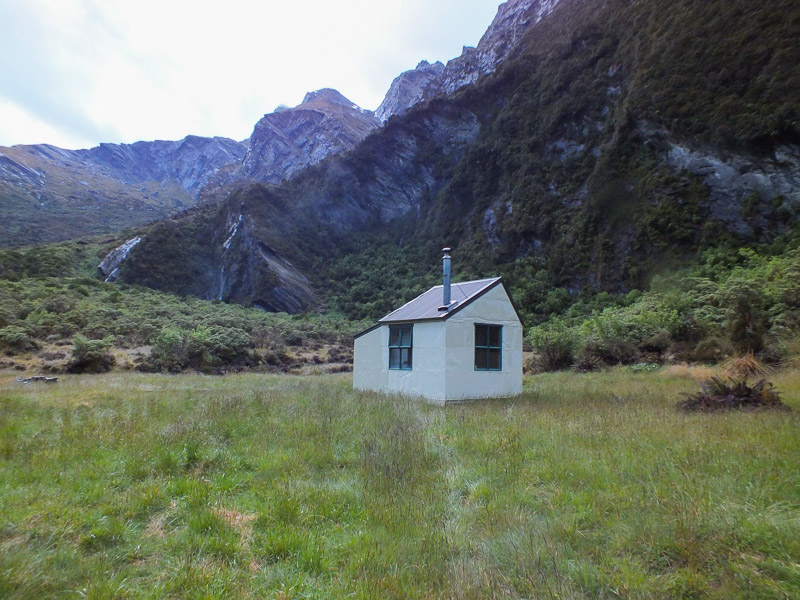
I set off down river following the rough track in the Upper Karangarua. The scenery slipped past with gratifying speed and the tops clouded over, as though shy to stay exposed for too long. The Karangarua River was small at this point and crossing would not have been difficult. I arrived at a confluence within an hour and the volume of the doubled, as the crystal waters of the Troyte River joined the Karangarua. It wouldn’t take much more water to make the river uncrossable.
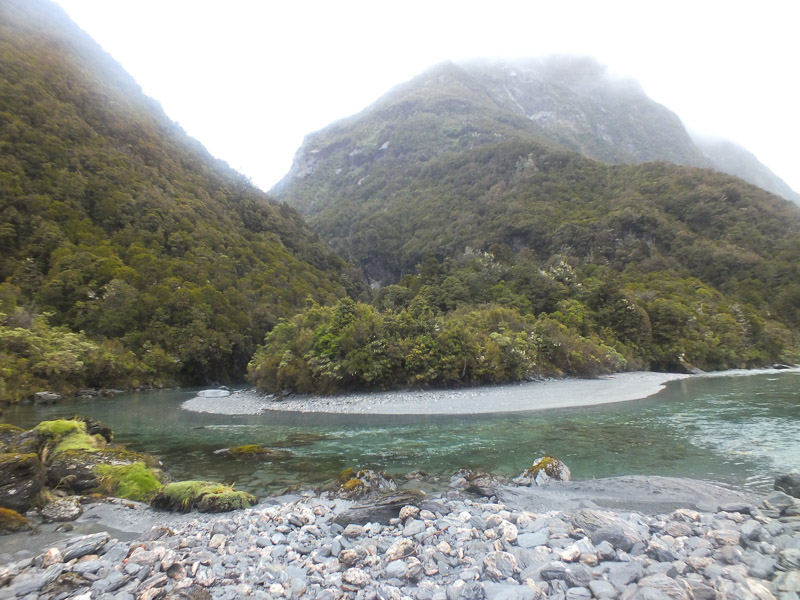
The crystal clear waters of the Troyte river meet the Karangarua and doubles its flow.
Lame duck hut appeared before I was expecting it, and a quick check of my watch confirmed I had beaten the times indicated by the . While I had been in the Landsborough, I had always been hours slower than the guidebook, it felt good to be ahead.
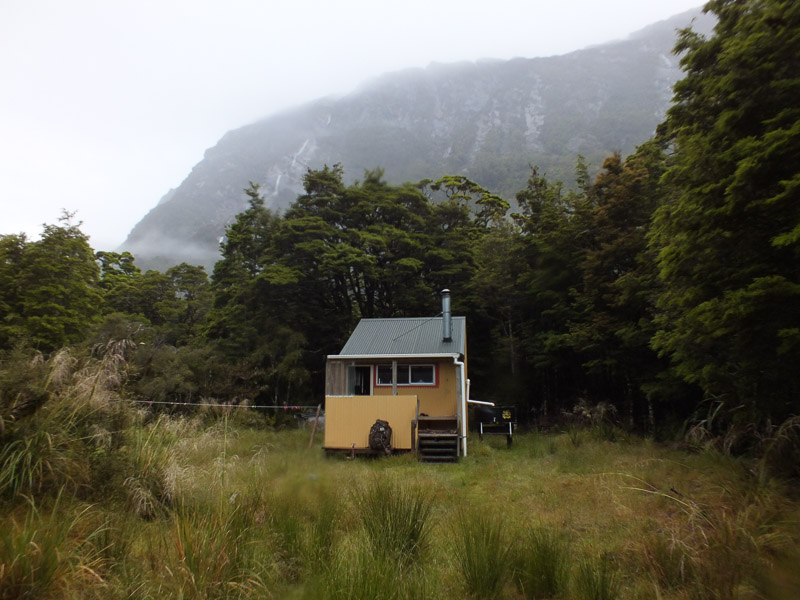
Lame Duck Flat was named by Charlie Douglas, who camped at the flat and watched his dog chase a pūtangitangi with an apparently broken wing. This is a classic trick used by Paradise Shelducks to lure predators away from their nest or ducklings.
I thought we were done with the scary stuff?!
From Lame Duck Flat the track headed uphill through a series of swampy plateaus and then into the bush. At times I was offered views of the country.

The track climbed up through the swampy scrub back into the bush. As It started to traverse, streams intersected it.
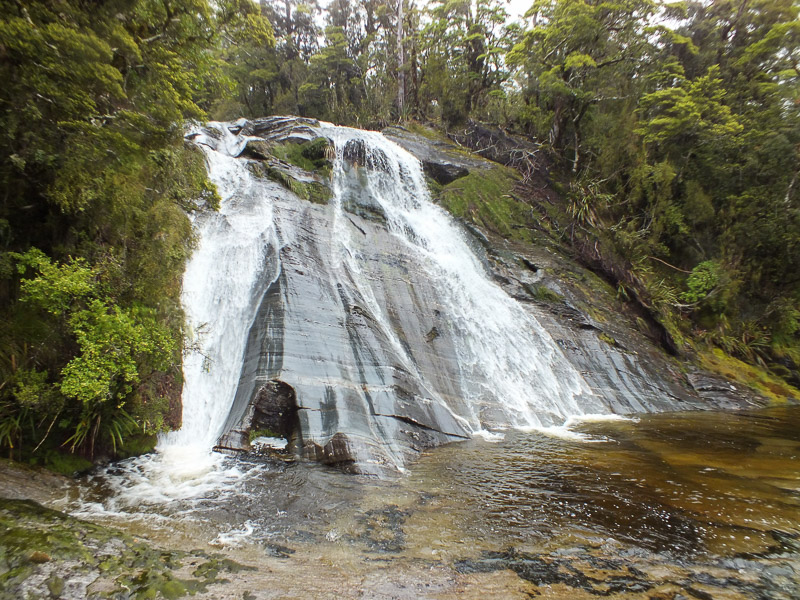
The track wound through sections of bush and crossed several streams. Some were steep and had spectacular fan waterfalls.

Despite having a marked track, the Karangarua was far from easy going. The track was rough and appeared to be seldom travelled. I was strolling along, when a rattling sound pulled me from deep in my own thoughts. A tahr kid ran along the track 5m in front of me, its hooves clacking on the rocks. Before I could react, it darted into the bush. I stood stunned for a few seconds, wondering if there would be more to follow. When none materialised, I walked to where it had disappeared and peered up through the bush. Nothing. It had vanished as quickly as it had appeared.
Shortly after, a stream swept across the track. It ran down through the bush in a steep chute, across solid rock, then plummeted down the hill at an angle of 30°. Moss clung to every available surface, and the whole thing looked like the most terrifying slip’n’slide ever made. A fall here would not be pretty, and would likely result in a helicopter trip or worse.
Oh, my goodness, I thought we had progressed beyond exposure.
I wasn’t expecting to be forced to dip into the courage reservoir on the track! I would have loved a rope about now.
The section of rock was quite narrow. The start was also problematic as a sloping slab of slippery stone had to be descended before the stream could be crossed. I edged down the slab and with one hand on a log above, stepped with a careful foot onto the ‘slide of doom.’ The friction of my boots on the slick rock did not inspire confidence. I slowly edged my other foot off its ledge. I felt myself slipping. I tried to hold onto the log. My foot skidded out from under me. I slid sideways on my hip and my boots plunged into the racing water. I jammed my feet into the chute and tried to brace against it. I sat locked against the slab with my feet in the water and bloodied fingers gripping onto small crimps in the slab.
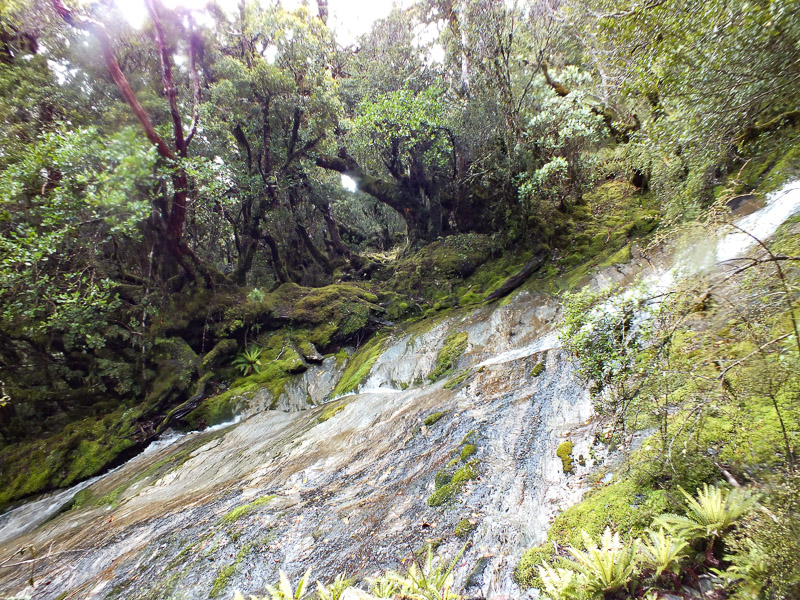
Looking back at the ‘stream of doom.’ You can see the track, a marker arrow and the log I used to try to descend the angled slab directly above the stream itself. It’s steeper than it looks, the picture doesn’t quite do it justice.
I sat frozen for a few seconds. Then with slow careful movements, turned so I was facing the rock. I pushed hard against the slab, smearing my palms on the rock, and was able to get a foot onto the other side of the stream. I edged out of the water and crouching, with my uphill hand leaning on the rock crept along the sloping rock. Treacherous seconds passed; the safety of the far bank hung out of reach. Another doubtful step and I grabbed a hanging fern. It wasn’t solid but it was enough to swing up onto the bank. My breath whooshed out of my lungs, and I realised I had been holding my breath.
After conquering the ‘stream of doom,’ I blasted along the hill, before descending back down to river flats. The river was much bigger than when I had left it. The drizzle turned to rain and the clear sky of the morning was a memory. The track flew beneath my feet, and it was not long before I had a brew at Cassel Flat Hut.
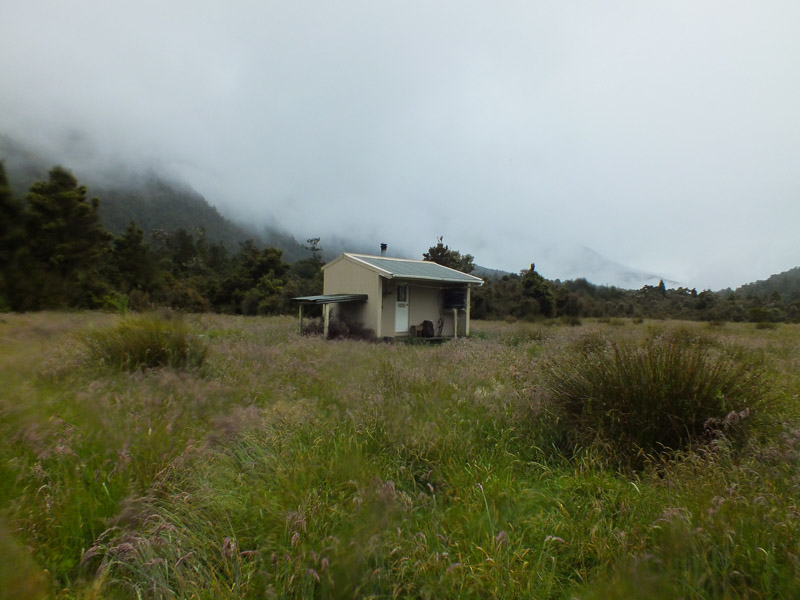
Pain and rain
I had planned on walking out of the Karangarua over two days, but I was making such good time it seemed silly to stop. I’d estimated it would take 9 hours to reach Cassell Flat Hut but had done it in 6. With plenty of day left remaining and only a few hours to the end I decided to push on.
I slammed a cup of coffee down my throat and slid my pack back onto my aching shoulders. The efforts of the three previous days had taken their toll. Persistent rain pattered on the foliage and there was little joy to be had trudging along through the wet bush. My large thighs, whilst good for power, are prone to chafing and four days of wet rubbing came to fruition in the lower Karangarua. I waddled along, the pack feeling 10kg heavier than at the start of the day. The further I went the better the track became, and track improved to meet the normal standard expected of a DoC track. It was now just a matter of chafing it out to the end.
Wide flats and winding sections of bush slipped past.
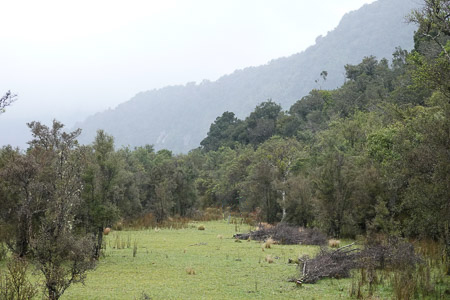
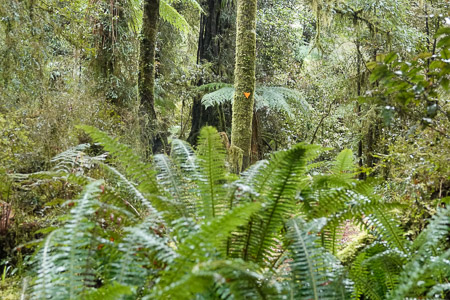
I could see on the map, that the Karangarua would soon be joined by its more famous sister. I hoped to glimpse the confluence but as the track snaked through the thick bush I passed the point without being offered a view. I just nodded at the bush in the general direction as I trudged past and acknowledged the Copland River joining its glacial waters with the Karangarua.
I was suffering. I’d punished my body for the better part of four days. The heavy pack, hard terrain and long days had accumulated as a heavy debt, and I was now confronted with the bill. Exhausted and soaking I staggered down the valley. The going was easy, but the effort to keep moving was immense. My legs were heavy and weak, my back and shoulders squealed like an unoiled engine. Even the soles of my feet ached. It felt very similar to the final kilometres of a marathon, and I knew I just had to grind it out.
I passed a landmark stream and counted the grid squares between me and the road. A bitter smile tugged at the corners of my mouth. My journey was almost over, there was only an hour of walking to go. An hour seemed so long. I had walked over 12 hours a day for the last three days, now the last remaining hour seemed like an intolerably long way. There was no avoiding it.
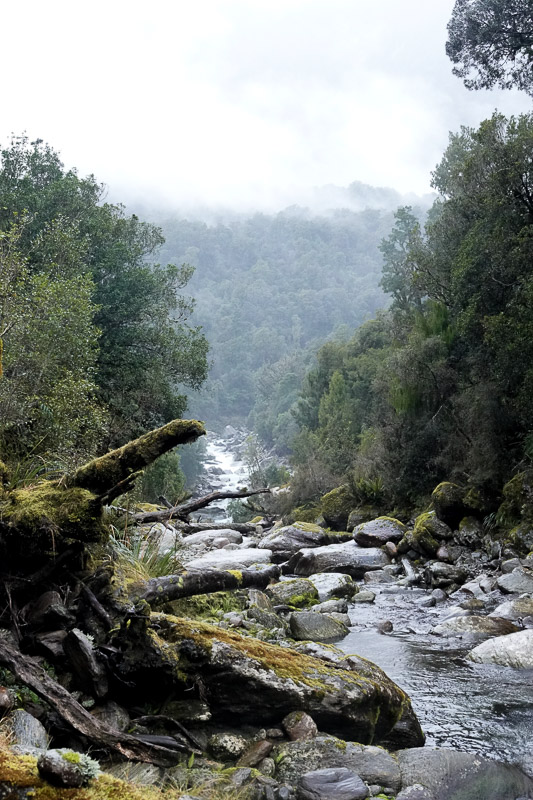
A stream flows down to the Karangarua below.
Sluggish minutes crept by. I wondered at the fickle nature if the human brain and the passage of time. I realised I was measuring my progress in minutes and by doing so was checking my watch every seconds. I hid my watch under my sleeve and tried to concentrate on the journey.
After an unknown period of time, I floundered out of the last bush section and the river appeared beside me.
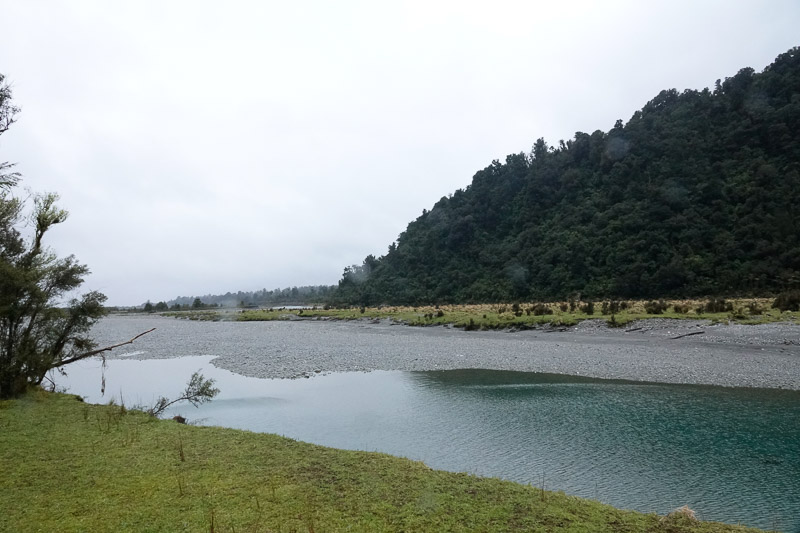
You wanted to do this I reminded myself.
This wasn’t supposed to be easy. I wanted a challenge. It was always going to be a suffer fest.
I gritted my teeth and sloshed down the sodden track.
Bittersweet
Then from through the trees I spotted the road bridge.
Unlike the wave of emotion I had felt upon summiting the Karangarua Saddle the day before, the end of the journey came slowly. I edged closer to the road and watched trucks rumble across the bridge as I plodded towards it. The end came incrementally, till eventually I stood in the tiny carpark by the bridge.
So. I did it.
With an underwhelmed shrug, I congratulated myself on having completed the most difficult accomplishment of my life.
I stood in the ugly gravel of the carpark, sore, soaked and sorry that the journey was over. For four days, I had been separated from society by hundreds of kilometres of wilderness, that distance now reduced to thin sheets of glass. Tourists peered out from behind their splattered windshields, windows wound up tightly against the driving rain. For a moment they seemed wonder who the dishevelled figure by the bridge was, where he had come from and what he had achieved. The thought flitted from their minds as the car rolled around another corner.